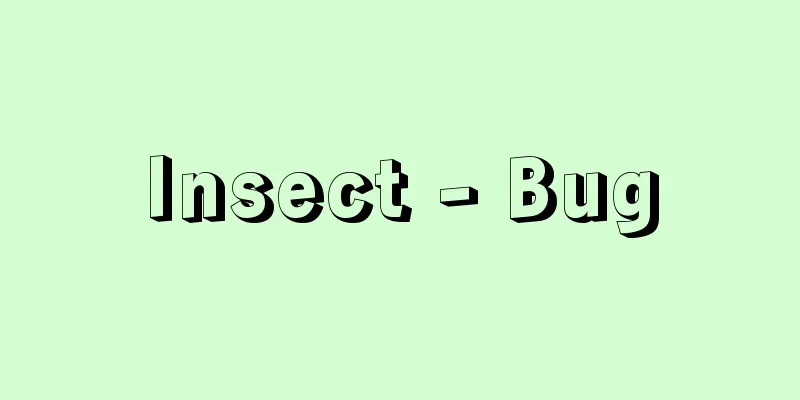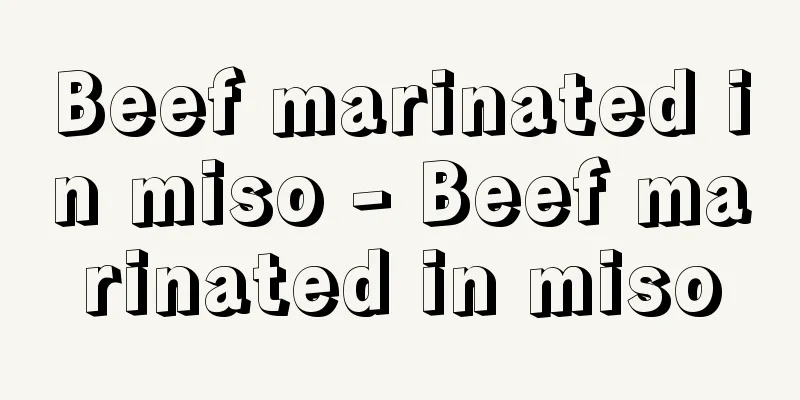Insect - Bug

|
Generally used as a general term for insects, it is also a general term for animals, with birds being called winged insects, animals being called caterpillars, turtles being called beetles, animals with scales like dragons being called scale insects, and humans being called naked insects. It is also used to refer to small animals excluding birds, animals, fish, and shellfish, to the three corpse worms that Taoism teaches live inside the human body, and to roundworms that parasitize the human body. In the early modern period, the existence of nine worms that live inside the human body and have various effects on a person's health and emotional movements was believed. [Toshihiko Uda] literatureIn classical literature, it is often used to broadly refer to small animals other than beasts, birds, and fish. In the Wamyōshō, insects with legs are called 'mushi' and insects without legs are called 'chi', and it is also said that they are the general name for rinkai (fish and shellfish). They are said to be found all over the human body and affect health and emotions (stomach bugs), are said to be the cause of children's illnesses (epidemic bugs), are used as a metaphor for being too passionate about something (bookworms) and are used to describe someone with contempt (weaklings). They also appear in folk traditions and customs, and in the entry for the third year of the reign of Emperor Kōgyoku (644) in the Nihon Shoki, there is an article about worshiping a silkworm-like insect (a caterpillar) as a 'Tokoyo no Kami' (god of eternal life). There is also a magical event called "Mushi Okuri" to drive away locusts and other pests that damage crops, and this is a seasonal theme for autumn. It is also said that if you sleep on the night of Koushin, the Sanshi mushi that live inside the human body will harm you and shorten your life, so there were also events such as worshiping gods and composing poetry all night long. In the "Manyoshu," there is a poem that reads, "If this world is happy, I will come to this world, even if it is a bug or a bird" (Volume 3, Otomo no Tabito), and the names of insects that appear in the "Manyoshu" include akizu (dragonfly), ka (mosquito), ko (silkworm), kohorogi (cricket), sugaru (bee), semi (cicada), tefu (butterfly), hahe (fly), higurashi, hihiru (moth), and hotaru (firefly). The section on Emperor Nintoku in the Kojiki metaphorically describes the three stages in which silkworms turn from cocoons to adulthood as "creeping insects," "drums," and "flying birds." Insects are sometimes called "mushikera" ("Toshikage" in the Utsubo Monogatari), but their cries are also popular, and in the Kokinshu, names such as kirigirisu (cricket), kumo (spider), cicada (temporal cicada), sugaru (confussed with deer), higurashi (cicada), hotaru (firefly), and matsumushi (perhaps a bell cricket) appear. Insects that swarm around summer fires are collectively called "summer insects," and this has already been seen in the Manyoshu, and is used as a metaphor for burning oneself in love, such as in the Kokinshu poem "The summer insects' bodies were also tormented by one thought" (Love 1). Insects would be released into the garden or placed in a cage and their sounds would be admired, or insect parties would be held where people would enjoy poetry, music, and the like (for example, "Nowaki" and "Suzumushi" in The Tale of Genji). In the "Insects" section of The Pillow Book, some examples include suzumushi (possibly a pine cricket), higurashi (cicada), tefu (tefu), matsumushi (matsumushi), kirigirisu (grasshopper), hataori (grasshopper), warakara (described in the Kokinshu and other works as an insect that lives in the weeds cut by fishermen), hio mushi (possibly a mayfly), firefly, bagworm (bagworm), nukazukimushi (possibly a click beetle), hahe (hae), summer insects, and ari (ants). Other insects that appear in The Pillow Book include nomi (flea; "something to hate") and kutsuwamushi (pink bug; "The flute"). Shimi (paper bugs) appear in "Hashihime" in the Tale of Genji. In the sixth volume of the Kokin Waka Rokujo, there are entries with themes such as insects, cicadas, summer insects, grasshoppers, crickets, bell crickets, nightingales, fireflies, grasshoppers, spiders, and tefu, and in the autumn volume of the Wakan Roeishu, there is an entry on insects. In "The Princess Who Loved Insects" in the Tsutsumi Chunagon Monogatari, a princess appears who prefers caterpillars to butterflies, collects praying mantises and snails, and gives boys names related to insects, such as kera (cricket), hiki (toad), locust, and amabiko (millipede). The "Kokonchomonju" vol. 20, "Fish, Insects, Birds and Beasts," contains a story about a man who was killed in retaliation by a louse, and an article about an insect selection event that is said to have begun during the Horikawa period during the Insei era, in which courtiers would hunt insects in the fields and present them to the Imperial Court. The Noh play "Matsumushi" contains onomatopoeia for insects, such as "kirihataricho" (grasshopper), "tsuzuri sasefu" (cricket), and "rin rin rin" (bell cricket). Yokoi Yayu's "Uzuragoromo" (Quail's Clothes) contains a "Hyakuchu no Fu" (Hyakuchu no Fu) that is all about insects, but the range of insects seems to have been wider, including amphibians, reptiles, and crustaceans such as frogs, snakes, and crabs. The seasonal theme is autumn, and the subject is insects gathering in the grass. [Teruhiko Komachiya] [References] | | |This is a nishiki-e (colored woodblock print) depicting the scenery of Mount Dokan (a hill stretching from the western edge of Arakawa Ward to the southeastern edge of Kita Ward in Tokyo), which was known as a famous spot for listening to insects. It is said that many people visited Mount Dokan in autumn evenings to enjoy the sounds of bell crickets (bell crickets) and pine crickets (pine crickets). Utagawa Hiroshige's "Meisho of the Eastern Capital: Mount Dokan's Listening to Insects" (National Diet Library collection ) Insect listening (insect listening) Source: Shogakukan Encyclopedia Nipponica About Encyclopedia Nipponica Information | Legend |
|
一般に昆虫類の総称として用いられるが、動物の総称でもあり、鳥を羽虫、獣を毛虫、亀(かめ)の類を甲虫、竜のように鱗(うろこ)のある動物を鱗虫(うろこむし)といい、人間を裸虫(はだかむし)などといったりする。また鳥獣魚貝などを除いた小動物を総称したり、道教で人間の体内にすむと説く三尸(さんし)の虫をいったり、人体に寄生する回虫などもいい、近世には、人間の体内にあって、その人の健康状態や感情の動きにさまざまな影響を与える9匹の虫の存在が信じられていた。 [宇田敏彦] 文学古典文学では、獣・鳥・魚以外の小動物を広くいうことが多い。『和名抄(わみょうしょう)』には、足のある虫を「蟲」、足のない虫を「豸(ち)」というとし、「鱗介(りんかい)(魚貝類)惣名也」ともある。人の体中にいて、健康や感情に影響を及ぼすとされたり(腹の虫)、子供の病気の原因とされたり(癇(かん)の虫)、物事に熱中することの比喩(本の虫)や軽蔑するときの形容(弱虫)に用いられたりする。民俗的な伝承や風習にもみえ、『日本書紀』皇極(こうぎょく)天皇3年(644)条には、蚕に似た虫(イモムシか)を「常世神(とこよのかみ)」として祭る記事がみえる。また、イナゴなど農作物を荒らす害虫を追い払う「虫送り」という呪術(じゅじゅつ)的な行事があり、秋の季題にもなっている。また、庚申(こうしん)の夜に眠ると、人の体内にいるという三尸虫が害をなし、命を縮めるといわれ、神仏を祭り、夜を徹して詩歌を詠むなどの催しも行われた。『万葉集』に、「この世にし楽しくあらば来(こ)む世には虫に鳥にも我はなりなむ」(巻3・大伴旅人(おおとものたびと))などと詠まれており、『万葉集』の虫には、あきづ(蜻蛉)、か(蚊)、こ(蚕)、こほろぎ(蟋蟀)、すがる(蜂)、せみ(蝉)、てふ(蝶)、はへ(蠅)、ひぐらし、ひひる(ひむし。蛾)、ほたる(蛍)などの名がみえる。『古事記』仁徳(にんとく)天皇条には「匍(は)ふ虫」「鼓(つづみ)」「飛ぶ鳥」と、蚕が繭となり成虫となる三態が比喩(ひゆ)的に記されている。虫は、「虫けら」(『うつほ物語』「俊蔭(としかげ)」)などとよばれることもあるが、鳴く声がもてはやされ、『古今集』には、きりぎりす(蟋蟀)、くも(蜘蛛)、せみ(うつせみ)、すがる(鹿と混同)、ひぐらし、ほたる、まつむし(鈴虫か)などの名がみえる。夏の火に群がる虫は「夏虫」と総称され、すでに『万葉集』からみられ、『古今集』の「夏虫の身をいたづらになすことも一つ思ひによりてなりけり」(恋1)などと、恋に身を焦がすことの比喩として詠まれた。虫は庭に放したり、籠(かご)に入れたりして、声を賞美したり、虫の宴を催して詩歌管絃(かんげん)を楽しむこともあった(『源氏物語』「野分(のわき)」「鈴虫」など)。『枕草子(まくらのそうし)』「虫は」の段には、すずむし(松虫か)、ひぐらし、てふ、まつむし、きりぎりす、はたおり(キリギリス)、われから(『古今集』などに、海人(あま)の刈る藻に住む虫、と詠まれる)、ひを虫(カゲロウか)、ほたる、みのむし(蓑虫)、ぬかづきむし(コメツキムシか)、はへ、夏虫、あり(蟻)などがあげられている。『枕草子』には、のみ(蚤。「にくき物」)、くつわむし(轡虫。「笛は」)などもみられる。『源氏物語』「橋姫(はしひめ)」には、しみ(紙虫)が出てくる。『古今(こきん)和歌六帖(ろくじょう)』六には、虫、せみ、夏虫、きりぎりす、まつむし、すずむし、ひぐらし、ほたる、はたをりめ、くも、てふ、の題があり、『和漢朗詠集』秋には、虫の項がある。『堤(つつみ)中納言物語』の「虫めづる姫君」は、蝶よりも毛虫が好きな姫君が登場し、いぼじり(カマキリ)やかたつむりを集めたり、男童にけら(オケラ)、ひき(ヒキガエル)、いなご、あまびこ(ヤスデ)など虫にちなむ名をつけたりする。『古今著聞集(ここんちょもんじゅう)』二十・魚虫禽獣(きんじゅう)には、白虫(シラミ)に報復されて死んだ男の説話、院政期の堀河(ほりかわ)朝に始まったという、殿上人たちが野で虫をとり内裏(だいり)に奉る虫撰(えら)びの行事の記事がみえる。謡曲『松虫』には、「きりはたりちょう」(キリギリス)、「つづりさせてふ」(コオロギ)、「りんりんりん」(スズムシ)という虫の擬声語が記されている。横井也有(やゆう)の『鶉衣(うずらごろも)』の「百虫譜(ひゃくちゅうのふ)」は虫尽くしになっているが、虫の範囲は広く、蛙(かえる)・蛇・蟹(かに)など、両生類・爬虫(はちゅう)類・甲殻類などにも及んでいたようである。季題は秋で、草むらに集(すだ)く虫が対象になっている。 [小町谷照彦] [参照項目] | | | |虫聴の名所として知られた道灌山(現在の東京都荒川区西端から北区南東端に続く丘陵)の風景を描いた錦絵。秋の夕刻、スズムシ(鈴虫)、マツムシ(松虫)などの声を賞美するため、多くの人々が訪れたという。歌川広重画『東都名所 道潅山虫聞之図』国立国会図書館所蔵"> 虫聴(虫聞) 出典 小学館 日本大百科全書(ニッポニカ)日本大百科全書(ニッポニカ)について 情報 | 凡例 |
>>: Musi River (English spelling)
Recommend
Payment statement - Payment statement
During the Edo period, this was one of the ledgers...
Sales book - Uricho
〘Noun〙 A general term for a ledger in which goods ...
Federated Malay States
The administrative structure of British Malaya (18...
Three things not to go, seven things to come out - Sanfukyōshichishūtsu (English)
In old China, there were seven reasons for divorci...
《Phonology》 - Oninron
…These studies were compiled in “Studies on the P...
Saros cycle
One of the cycles in which solar and lunar eclips...
Onasiogiyogi - Swimming without permission
...Both the dorsal and ventral branches have gona...
Iimoriyama
[1] [noun] A mountain shaped like a pile of rice. ...
Zubinian hookworm - Zubinikochu
A parasitic worm of the family Ancylostoma. Body l...
Family: Craneidae - Craneidae
…It is said that males detect the intrusion of fe...
Poland - Republic of Poland (English spelling)
A republic in central Europe. It borders the Balt...
Slimy
Many foods contain slimy substances, including ve...
Hypothesis Testing
...Based on this premise, inferences about parame...
micturition
…In this way, the kidneys finally produce urine w...
Genus Asteraceae - Asteraceae
…A general term for the genus Nierembergia . A pe...





![Hatage [Hot Spring] - Hatage](/upload/images/67cc85fc1ea30.webp)



